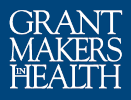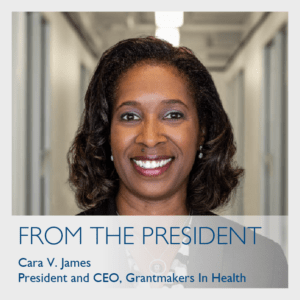Cara V. James, PhD, President and CEO, Grantmakers In Health
At a moment when so much has been described as “unprecedented”, and so much of what we value is being attacked, we need to ask ourselves as individuals, organizations, and a field, what do we stand for? What values do we hold, and what will we do and say to defend them?
We are one month into the new administration, and it is clear that things are going to be very different this time. Like many, we at Grantmakers In Health have watched with a mix of anger, sadness, and disbelief at the flurry of activity associated with the past few weeks. Activities that have serious and significant health implications. Highlights include the removal of critical health data and research reports; suspension of all diversity, equity, and inclusion programs and funding, and firing related federal staff; attempted erasure of transgender individuals from data and society; freezing critical funding to support life-saving global health programs, health research, and training programs for future health leaders; freezing of funding and firing of federal civil service employees who work on programs that support the most vulnerable in our communities; and so much more. Meanwhile on Capitol Hill, potential spending reforms in the House include significant cuts to Medicaid, the Supplemental Nutritional Assistance Program (SNAP), and Temporary Assistance to Needy Families (TANF).
If these cuts are enacted, uninsured rates will increase, and hospitals will close, leading to decreased access to care and worse health outcomes. These efforts will do nothing to improve the health and well-being of our communities, nor will they address the critical challenges we face. Instead, they are already having—and they will continue to have—negative impacts on communities across the country, irrespective of whether the residents of those communities voted Democratic, Independent, Republican, or not at all. And we know there is more to come.
Health philanthropy is at a critical juncture. We cannot do what we have always done, or even what we did during the pandemic. The circumstances are different. During the pandemic, numerous funders increased their giving to support the needs of their community, but those increases were time-limited, and they were done in concert with additional federal and state resources, not as a replacement for them. We are already working to protect the communities we care about from potentially devastating budget and programmatic cuts—and from legislation that would limit our ability as a field to do the work we need to do to improve health and reduce disparities. But we know funders do not have the same resources as the government, and philanthropy cannot fill the gap should Congress pass trillions of dollars in cuts.
We also know it is the government’s responsibility to address social issues such as health and education on a large scale, while philanthropy tends to focus on unmet needs and things the government cannot do. If philanthropy steps into what is fundamentally a governmental role, it absolves government of its responsibility and it would remove the incentive for government to fulfill its role, leaving philanthropy to try and fill the gap for an undefined amount of time.
As I think about how we should meet this moment, I am reminded of a scene from Gladiator (2000), in which Maximus rallies his fellow gladiators before entering the Colosseum, telling them that they should stand together no matter what comes at them when the gates open—that they stand a better chance together than if they go it alone.
Now more than ever, we need to stand together, work together, and collaborate with allies inside and outside of health philanthropy to strategize and act. We need to be clear about what we stand for. We need to use our voice to speak out in support of health-promoting policies and actions and against the policies and actions that undermine health and our values. We also need to develop long-term strategies that move us from defense to offense and promote the enactment of policies, programs, and funding that support our vision of better health for all.
Like many organizations, Grantmakers In Health remains committed to our mission, vision, and values. We will continue working with health funders and other stakeholders to achieve better health for all through better philanthropy. We believe that vision is achievable by working across our five focus areas: 1) access and quality, 2) community engagement and empowerment, 3) health equity and social justice, 4) population health, and 5) philanthropic growth and impact, and we will continue to advocate for the policies, programs, and systemic changes needed to promote better health across these domains.
We also remain committed to the values that guide our work. Values that include but are not limited to respect; integrity and transparency; collaboration; and diversity, equity, and inclusion. We are committed to treating the people and organizations with whom we work with fairness, dignity, and respect, and recognize and appreciate the achievements and contributions of all. We are committed to acting honestly and transparently, in accordance with internal policies and external laws and regulations. We support systemic change and accordingly value collaboration with other sectors that affect health. We are committed to promoting diversity, equity, and inclusion in our programming, personnel, employment practices, and governance, and we view diversity as a fundamental element of social justice and democracy and is integral to our mission. These values have largely been absent from national policies, actions, and discourse since the inauguration. Yet, they are values I think we can agree on.
During the last month, GIH has worked to keep funders connected, share updates, strengthen collaborations with other philanthropy serving organizations, and connect with other health care and public health organizations. We hosted webinars on the state of health policy in Congress and the new administration and on the Supreme Court’s impact on health and health equity. We encouraged health funders to use their voice to tell their representatives how their communities would be impacted by cuts to Medicaid. In the coming weeks, we plan on expanding our Learning Communities to provide even more opportunities for direct collaboration and engagement. We are also maintaining a curated list of upcoming convenings from others in the field to help spread the word about opportunities to come together. And there is more to come.
Philanthropy has a long history of supporting social change. Foundations provided critical support to the Civil Rights Movement through the Voter Education Project, legal defense, and more. Philanthropy helped design the Head Start program and continues to support its implementation. Funders also supported analyses to advance the Mental Health Parity and Addiction Equity Act (MHPAEA) of 2008, outreach and enrollment for the Affordable Care Act, and numerous advocacy efforts at the state and local level. In contrast, philanthropy also helped fund the effort to overturn Roe v. Wade and Students for Fair Admissions (SFFA), the organization that sued Harvard and the University of North Carolina over their admissions practices. Change is possible, but it takes time, effort, and sustained support.
These are difficult days for those of us working to improve health and who value respect; integrity and transparency; collaboration; and diversity, equity, and inclusion. It is vital that we come together to organize, strategize, collaborate, and communicate. It is also vital that we know what we stand for, and that we stand together and support each other and our partners through whatever comes at us because we know we are more likely to achieve our vision of a healthier future for everyone by working together than apart.

